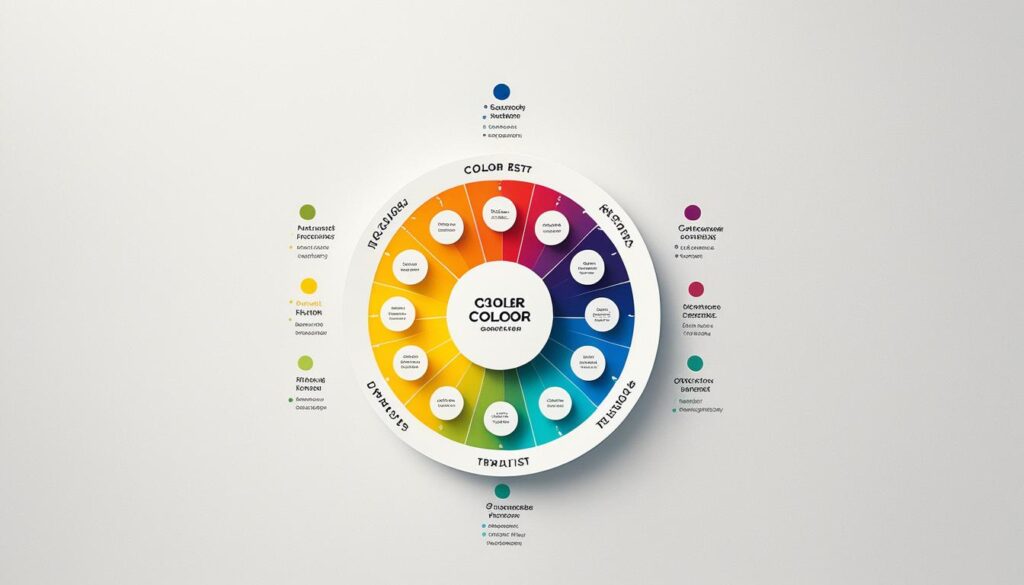Did you know that your favorite colors can provide interesting insights into your personality? Surprising as it may seem, in-depth studies in color psychology have demonstrated that our color choices can mirror our characteristics, inclinations, and overall perspective on life. Whether you lean towards calming blues, energetic oranges, cozy golds, or refreshing greens, each color is linked to specific personality traits.
As humans, we are naturally curious about ourselves and the people around us. We constantly seek to understand and connect with others on a deeper level. By diving into the realm of color personality tests, we can gain valuable insights into our own unique traits and how they impact our daily lives.
In this article, we will explore the fascinating world of color personality tests and delve into the traits associated with different colors. Are you ready to discover your true colors and unlock a deeper understanding of yourself? Let’s begin this exciting journey together!
Key Takeaways:
- Color personality tests offer valuable insights into individuals’ traits and characteristics.
- Blues are compassionate and goal-oriented, while oranges are energetic and friendly.
- Golds are structured and organized, while greens are analytical and innovative thinkers.
- Color psychology suggests that colors can evoke positive feelings and enhance overall well-being.
- By incorporating colors associated with positivity, you can create a more joyful and uplifting environment.
Understanding the Blue Personality
The blue personality type embodies compassion, patience, and a people-oriented approach. As dependable employees and strong leaders, blues prioritize collaboration and derive satisfaction from efficiency and accomplishment. They genuinely enjoy working with others and place a high value on emotional connections.
“Blues are characterized by their genuine concern for others and their willingness to go the extra mile to support those around them. Their compassionate nature creates an atmosphere of warmth and understanding, fostering positive relationships within teams and organizations.”
Blues excel in environments that allow them to express their caring nature and make a positive impact on those they interact with. They are known for their active listening skills, empathy, and ability to provide comfort and reassurance to others during challenging times.
A People-Oriented Approach
Blues place a strong emphasis on building meaningful connections and maintaining harmonious relationships. They value collaboration, cooperation, and understanding.
- Blues thrive in team-oriented environments, leveraging their exceptional interpersonal skills to foster a sense of unity and cooperation.
- They bring people together, actively seeking ways to bridge gaps and resolve conflicts through open communication and empathy.
- Blues are compassionate listeners, making people feel seen, heard, and understood.
Blues derive a sense of purpose and fulfillment from supporting others and making a positive impact on their lives. Their ability to create a harmonious atmosphere contributes to their effectiveness as leaders and team members.
Exploring the Orange Personality
The orange personality type is characterized by being energetic, charming, and action-oriented. Oranges are extroverted individuals who thrive in social settings. They possess an innate ability to radiate positivity and easily connect with others. Their lively and outgoing nature makes them the life of the party, bringing excitement and enthusiasm to any gathering.
Oranges are known for their vibrant energy and their ability to inspire those around them. Their enthusiasm and zest for life are contagious, making them magnetic personalities. They possess a natural charm that draws people towards them, making others feel instantly comfortable in their presence.
One of the key traits of the orange personality is their action-oriented nature. They are driven by a desire to achieve their goals and make things happen. Oranges thrive in fast-paced environments and enjoy taking on new challenges. They are not afraid to step out of their comfort zone and embrace new experiences with open arms.

While oranges may appear confident and carefree, they are also incredibly supportive individuals. They genuinely care about the well-being of others and are always willing to lend a helping hand. Oranges are known for their optimism and are often a source of encouragement and motivation for those around them.
In relationships, oranges are passionate and adventurous partners. They value deep connections and prefer smaller gatherings that allow them to form more intimate relationships. However, their eagerness to form new connections can sometimes lead to heartbreak if a relationship doesn’t work out. Nevertheless, they possess the resilience to bounce back quickly and easily form new connections.
Notable Traits of the Orange Personality:
- Energetic and enthusiastic
- Charming and charismatic
- Action-oriented and goal-driven
- Supportive and optimistic
- Resilient and quick to form new connections
The orange personality type brings a breath of fresh air wherever they go. Their vibrant energy and magnetic personality make them unforgettable individuals who leave a lasting impression on those they encounter.
Uncovering the Gold Personality
The gold personality type shares similarities with blues in terms of being structured and organized. However, golds prioritize structure over collaboration. They are disciplined, dedicated, and value punctuality. Golds excel at planning, setting clear goals, and following strict schedules.
Unlike blues who thrive in team environments, golds prefer to work independently and take full responsibility for their tasks. Their methodical and detail-oriented nature makes them excellent planners and problem solvers. Golds bring structure and order to any project, ensuring that everything is organized and on track.
Key Traits of the Gold Personality:
- Responsible: Golds take their commitments seriously and can always be relied upon.
- Methodical: They have a systematic approach to tasks, paying attention to every detail.
- Structured: Golds thrive in structured environments and appreciate well-defined processes and procedures.
- Punctual: They prioritize timeliness and value being on time for appointments and deadlines.
- Disciplined: Golds have a strong sense of self-discipline, allowing them to stay focused and dedicated to their goals.
Gold personalities understand the importance of effective planning and enjoy creating strategies that lead to success. Their ability to stay organized and follow routines allows them to accomplish their tasks efficiently.
As responsible planners, golds bring a sense of order and structure to any situation. They excel at breaking down complex tasks into manageable steps and setting realistic goals. Their attention to detail ensures that nothing falls through the cracks.

Analyzing the Green Personality
The green personality type is characterized by being analytical, independent, and innovative. Greens enjoy problem-solving and see challenges as opportunities. They think outside the box and often have unique perspectives. Greens excel at analyzing situations, but being wrong can be detrimental to their confidence.
Key Traits of the Green Personality:
- Analytical: Greens have a natural inclination for analysis. They enjoy breaking down complex problems into smaller, manageable parts to find creative solutions.
- Independent Thinkers: Greens value their independence and prefer to work autonomously. They are self-motivated and rely on their own judgment when making decisions.
- Innovative: With their unique perspectives, greens often come up with innovative ideas and approaches. They are open to exploring unconventional methods and pushing boundaries.
“Being green means constantly seeking new ways to approach challenges and bringing fresh perspectives to the table. Our analytical nature allows us to dig deep and find innovative solutions that others may not have considered. However, we must be cautious about the impact of being wrong on our confidence.”
To better understand the green personality, let’s take a look at a comparison table:
| Personality Trait | Green Personality | Other Personalities |
|---|---|---|
| Analytical Thinking | Strong | Moderate |
| Independence | High | Varies |
| Innovativeness | High | Moderate |
| Confidence in Being Wrong | Low | Varies |

The Accuracy of Color Personality Tests
Color personality tests, such as the True Colors Personality Test, offer valuable insights into our unique traits and characteristics. While the accuracy of these tests may vary, they serve as a starting point for self-reflection and gaining self-insight. It’s important, however, not to take the results too seriously, as quizzes and tests can oversimplify the complex nature of individuals.
These tests can be a fun and engaging way to explore different aspects of our personalities. They help us understand our strengths, weaknesses, and preferences, allowing us to develop a better understanding of ourselves and those around us. By uncovering our color personality type, we gain valuable insights that can aid personal growth and improve our relationships.
Taking a color personality test can be a fun way to gain self-insight and explore different aspects of your personality.” – Dr. Samantha Green, Psychologist
The True Colors Personality Test, in particular, provides accurate and detailed results based on your responses to a series of questions. It categorizes individuals into four primary colors, each representing unique personality traits:
- Blue: Compassionate, people-oriented, and dependable.
- Orange: Energetic, charming, and action-oriented.
- Yellow/Gold: Structured, responsible planners.
- Green: Analytical, independent thinkers.
While color personality tests can offer valuable insights, it’s essential to approach them with an open mind and understand that they are not definitive measures of our personalities. They provide a framework for self-exploration and understanding, but they should not be used to label or limit ourselves or others. The true extent of our personalities goes beyond the boundaries of these tests.

Ultimately, the accuracy of color personality tests lies in their ability to spark self-reflection and promote a deeper understanding of ourselves and others. By embracing the insights gained from these tests, we can embark on a journey of personal growth and cultivate more meaningful connections with those around us.
Primary Colors in Personality Tests
Most color personality tests provide a primary color result along with associated personality traits. In the case of the True Colors Personality Test, the primary colors are blue, orange, yellow/gold, and green.
Blues are compassionate and people-oriented individuals. They are known for their ability to empathize, their strong sense of loyalty, and their deep connections with others. Blues excel in professions that require interpersonal skills and emotional intelligence. They are often seen as the pillars of support in their social circles, and their nurturing nature makes them great caregivers and counselors.
Oranges, on the other hand, are energetic and action-oriented individuals. They bring an infectious enthusiasm to every situation and are natural-born leaders. Oranges thrive in competitive environments and enjoy the thrill of taking risks. Their charismatic personalities make them great public speakers and salespersons.
Yellow/golds are detail-oriented and responsible planners. They have an innate need for structure and organization. Their meticulous nature allows them to excel in roles that require attention to detail and adherence to timelines. Yellow/golds are reliable and dependable individuals who value stability and predictability. They excel in fields such as accounting, project management, and event planning.
Lastly, greens are analytical independent thinkers. They have a natural curiosity and a thirst for knowledge. Greens are great problem-solvers and critical thinkers. They excel in fields that require innovation and creativity. Their ability to think outside the box allows them to come up with unique solutions to complex problems.
“The primary colors in personality tests offer valuable insights into the traits and characteristics of individuals. By understanding your primary color, you can gain a better understanding of yourself and others, leading to stronger relationships and personal growth.”
Here is a table summarizing the primary colors and associated personality traits in color personality tests:
| Primary Color | Personality Traits |
|---|---|
| Blue | Compassionate, people-oriented, empathetic |
| Orange | Energetic, action-oriented, charismatic |
| Yellow/Gold | Detail-oriented, responsible planners, reliable |
| Green | Analytical, independent thinkers, creative |

Understanding the primary colors and their associated personality traits can provide valuable insights into our behavior, preferences, and interactions with others. By recognizing the dominant color in our personalities, we can enhance self-awareness and cultivate stronger relationships.
Taking the Color Personality Test
Are you curious about what your color personality says about you? Online color personality tests provide a fun and interactive way to explore different aspects of your personality. One popular test is the KTestOne test on TikTok, which has gained significant popularity among users. To discover your color or personality type, you’ll typically need to answer a series of questions that assess your preferences, behaviors, and attitudes.
The results of the color personality test often include descriptive traits that align with your color type. These traits can provide valuable insights into your strengths, weaknesses, and motivations. Some tests even go a step further by suggesting compatible personality types or providing guidance on personal growth and development.
It’s important to note that color personality tests are intended for entertainment purposes and should not be taken too seriously. While they offer a glimpse into your personality, they are not scientifically validated tools. Instead, think of them as online quizzes that provide a lighthearted way to explore different aspects of your character.
“The colors of your personality can reveal fascinating insights and uncover new dimensions of self-awareness.”
Color aesthetic also plays a significant role in these tests. By associating colors with specific personality traits, the test creators aim to spark a visual representation of your character. This adds an extra layer of engagement and enjoyment to the test-taking experience.
So why not take a break from your daily routine and give a color personality test a try? It’s a fun activity that can offer new insights into your character while providing a dash of self-discovery and amusement.

| Color Personality | Personality Traits |
|---|---|
| Blue | Compassionate, patient, people-oriented |
| Orange | Energetic, charming, action-oriented |
| Gold | Structured, responsible planners |
| Green | Analytical, independent thinkers |
The Power of Colors in Positive Psychology
Color psychology suggests that certain hues have the ability to evoke positive feelings and enhance overall well-being. Surrounding yourself with colors associated with positivity can have a significant impact on your mood and mindset. Embracing the transformative power of colors can be a simple yet effective way to attract positivity in your life.
Colors have the power to influence our emotions and mental state. Research in color psychology has shown that different colors can evoke specific emotions and feelings. For example, warm colors like yellow and orange are often associated with feelings of happiness, energy, and optimism, while cool colors like blue and green can evoke feelings of calmness, tranquility, and relaxation.
By incorporating colors that promote positive feelings into our surroundings, we can create an environment that enhances our overall well-being. Whether it’s painting our walls, adding colorful accents to our decor, or even wearing clothes in uplifting hues, the colors we choose can have a profound impact on our mood.
The Effects of Different Colors in Positive Psychology
Each color has its own unique effect on our emotions and well-being. Here are some examples of the positive effects associated with specific colors:
- Yellow: Associated with happiness, optimism, and creativity. The color yellow can stimulate mental activity and enhance mood.
- Orange: Known for its energizing and joyful qualities, orange can boost enthusiasm and promote a positive outlook.
- Green: Symbolizing nature and growth, green is associated with feelings of balance, harmony, and renewal.
- Blue: Often linked to feelings of calmness and relaxation, blue can reduce stress and promote a sense of tranquility.
- Purple: Representing creativity and spirituality, purple can inspire imagination and encourage introspection.
- Pink: Often associated with love and compassion, pink can create a soothing and nurturing atmosphere.
Understanding the effects of different colors can help us make intentional choices in our surroundings to enhance our well-being and promote positive feelings.

“Color is a power which directly influences the soul.” – Wassily Kandinsky
Renowned artist Wassily Kandinsky aptly captured the transformative power of color. Just as colors can evoke emotions and influence our mood, they can also enhance our overall well-being. By embracing the positive effects of colors, we can create a vibrant and uplifting environment that supports our emotional and mental health.
| Color | Positive Effects |
|---|---|
| Yellow | Associated with happiness, optimism, and creativity. Stimulates mental activity and enhances mood. |
| Orange | Energizing and joyful. Boosts enthusiasm and promotes a positive outlook. |
| Green | Symbolizes balance, harmony, and renewal. Enhances feelings of tranquility and connection with nature. |
| Blue | Calming and relaxing. Reduces stress and promotes a sense of tranquility. |
| Purple | Associated with creativity and spirituality. Inspires imagination and introspection. |
| Pink | Representative of love and compassion. Creates a soothing and nurturing atmosphere. |
Surrounding ourselves with colors that evoke positive feelings is a simple yet powerful way to enhance our well-being. By incorporating these colors into our lives, whether through our environment, clothing choices, or artistic expressions, we can invite positivity and joy into our everyday experiences.
Embracing Positivity through Color Personality Testing
Taking the color personality test and exploring the traits associated with each color can be a way to enhance your well-being. By understanding your personality type and incorporating colors associated with positivity, you can create a more uplifting and joyful environment. Let the colors around you reflect the positivity you seek in life.
When you discover your color personality type, you gain valuable insights into your unique strengths and characteristics. This self-awareness allows you to align your surroundings with your personality, enhancing your overall well-being.
For example, if you have a blue personality, known for compassion and people-orientation, you can surround yourself with calming shades of blue in your home or workspace. This can create a soothing and nurturing environment that promotes positive relationships and a sense of tranquility.
On the other hand, if you resonate with the energetic and action-oriented nature of the orange personality, you might choose vibrant shades of orange and warm tones to add dynamism and excitement to your surroundings. These colors can inspire creativity and boost your motivation.
Here is a table summarizing the colors associated with each personality type:
| Personality Type | Associated Color |
|---|---|
| Blue | Calming shades of blue |
| Orange | Vibrant shades of orange |
| Gold | Warm tones and yellows |
| Green | Earthy and fresh greens |
Remember, embracing positivity through color personality testing is not just about the colors themselves, but also about the emotions and associations they evoke within you. Choose colors that uplift your spirits, promote your well-being, and align with your personal preferences.
So, why wait? Take the color personality test, discover your true colors, and start incorporating the power of colors in your life. Let your surroundings reflect the positivity and joy you deserve.
Conclusion
As we navigate through life, the colors we surround ourselves with have a significant impact on our mood and mindset. The color personality test provides valuable insights into our traits and characteristics, enabling us to better understand ourselves and others. By embracing the power of colors and incorporating positivity into our lives, we can create a more joyful and fulfilling existence.
Through the color personality test results, we gain deeper self-awareness. We uncover aspects of our personality that may have been hidden or underappreciated. Armed with this knowledge, we can make intentional choices about the colors we surround ourselves with in our environments.
By intentionally incorporating colors associated with positivity into our lives, we can enhance our well-being. Colors have the ability to evoke specific emotions and feelings, and by choosing colors that promote positivity, we can shape our mood and mindset for the better. Whether it’s painting our walls in vibrant hues or wearing clothes in joyful shades, embracing color and positivity can infuse our daily lives with a greater sense of joy and happiness.
FAQ
What is a color personality test?
A color personality test is a type of assessment that categorizes individuals into different groups based on their responses. It uses colors to represent specific personality traits and characteristics.
How does the color personality test work?
The color personality test typically involves answering a series of questions. Based on your responses, you are assigned a color or personality type that reflects your predominant traits.
What are the different color personality types?
The color personality test typically uses four colors: blue, orange, gold, and green. Blues are compassionate and people-oriented, oranges are energetic and action-oriented, golds are structured and responsible planners, and greens are analytical independent thinkers.
Can color personality tests accurately determine my personality?
The accuracy of color personality tests may vary. While they can provide insights and serve as a starting point for self-reflection, it’s important not to take the results too seriously as quizzes and tests can simplify the complexity of individuals.
How can the color personality test benefit me?
The color personality test can provide insights into your traits and characteristics, helping you better understand yourself and others. It can also be a fun way to explore different facets of your personality.
Are there different versions of the color personality test available?
Yes, there are various versions of the color personality test available online. Popular ones include the True Colors Personality Test and the KTestOne test on TikTok.
What is the power of colors in positive psychology?
Color psychology suggests that certain hues have the ability to evoke positive feelings and enhance overall well-being. Surrounding yourself with colors associated with positivity can have a significant impact on your mood and mindset.
How can I embrace positivity through color personality testing?
By taking the color personality test and incorporating colors associated with positivity, you can create a more uplifting and joyful environment. Let the colors around you reflect the positivity you seek in life.
Felicity, our Author, pens in-depth articles and guides that delve into the heart of personal discovery. Her narrative-driven approach weaves together theory, practice, and personal anecdotes, making the journey of self-exploration both relatable and inspiring. Felicity’s contributions help illuminate the path for those seeking a deeper understanding of themselves and their relationships.










